The Mother of Universal Charity

(1701
-1771)
By Roger
Zielke
 |
|
We
are about to tell you a wonderful love story… that of Mother d’Youville.
Indeed, her charity knew no bounds and her love for the poor was immense.
She made great sacrifices to help and comfort the poor and during
her life, her physical help or her prayers consoled hundreds and hundreds
of people. She sought God in the simplicity of her heart and found
Jesus in the poor, and she lived the words of the Gospel to the fullest,
Matthew Chap 25 vs. 40: “. . . as long as you did it to one of
these my least brethren, you did it to me.” But the words that
were most engraved in her heart, were those of St. Paul; Chap 13:
4-7 “Charity is patient, is kind; charity envieth not, dealeth
not perversely, is not puffed up, is not ambitious, seeketh not her
own, is not provoked to anger, thinketh no evil; rejoiceth not in
iniquity, but rejoiceth with the truth; beareth all things, believeth
all things, hopeth all things, endureth all things.” Throughout
her life, Marguerite put these words of St. Paul into practice to
the fullest. By doing this she gained the honor of being called the,
“Mother of Universal Charity”.
Marguerite
was born on October 15, 1701 at Varennes, Quebec and was baptized
the next day at St. Anne’s parish church. After her baptism, her father
placed her on the knees of her maternal great-grandfather for the
traditional blessing: “May God bless you, my little one, as I bless
you!” She was the first child of Captain Christophe Dufrost de
Lajemmerais and Marie Renée Gaultier de Varennes. Five other children,
two girls and three boys, were born into this happy family. Lieutenant
Lajemmerais was promoted to the rank of Captain, in June 1705. This
was the highest rank that a soldier of the colonial troops could attain.
He was promoted because of his fidelity to his duty, his spirit of
self-sacrifice, his prompt willingness to take any assignment.
|
|
|
The Ursuline Convent of Quebec
(established in 1639) |
On
June 1, 1708, Marguerite’s childhood was tragically disrupted by the
death of her father. This was a time of insecurity. The salary of
Captain de Lajemmerais had been large enough to keep his growing family
but not sufficient to provide savings for the future. Our young friend
learned very early how to think of others as she helped her mother
provide for her destitute family. Marie Renée now had to depend on
the charity of others for the needs of her children. And worse still
– it would be another six years before she would receive a widow’s
pension. This was due to complex formalities and slow communication
between France and her colony of Canada.
Because
she was extremely intelligent, Marguerite was greatly admired by her
great-aunt, Mother St. Pierre, an Ursuline nun, and several other
persons. So in 1712, in order to pursue her studies, Marguerite was
taken in a little rowboat to the boarding school at the Ursuline Convent,
in Quebec City; some hundred and fifty miles away. There she received
a good education from the nuns and also a good spiritual training.
At the convent school, Marguerite was a strong young girl with an
attractive personality and she was admired for a goodness and a maturity,
well beyond her age. She acquired the habit of meditating daily on
some page of a little book dealing with the “Holy Ways of the Cross”.
In 1714, at the age of almost 13, after two years at the boarding
school, Marguerite received her First Holy Communion. But the girl
could not stay in the convent for a lengthy time. Mme. Lajemmerais
could not afford to leave Marguerite in Quebec any longer, even with
the help of relatives and friends. There were still five other children
to be educated. So our friend was obliged to go back to Varennes that
same year, to help at home and to teach her brothers and sisters.
Marguerite was an invaluable help to her mother. By her handiwork,
she contributed skillfully to the support of the family and often,
as she was making fine lace, she would tell wonderful stories to her
brothers and sisters.
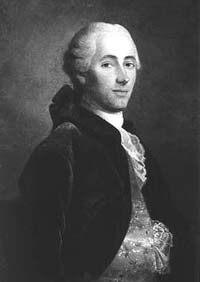 |
|
François d’Youville (1700-1730) |
|
As
a young woman, Marguerite became very popular in the social life of
Varennes. At 18, she got engaged to a young man whom she deeply loved.
But the promise of a happy marriage ended abruptly when her mother
remarried beneath her social class, an act that was unacceptable to
the family of Marguerite’s fiancé. We imagine the sorrow this produced
in the hearts of the two friends… Two years later, Marguerite moved
to Montreal with her family. There she became associated with the
aristocracy of old Montreal who in time noticed that she was graceful,
well mannered, serious and reserved. Before long, Marguerite met François
d’Youville and once again, fell in love. She married him on August
12, 1722, in Notre Dame Church, in Montreal, when she was almost 21
years old. The newly married couple moved in with François’ mother,
an avaricious and domineering woman who made life miserable for Marguerite.
During the frequent absences of her husband her mother-in-law was
most unsympathetic towards her. But worse yet, it soon became evident
to Marguerite that François was indifferent, selfish and covetous;
he was interested only in making money! During this time she had no
idea about her husband’s business; as he was gone for long periods
of time. Actually he was engaged in the illicit trading of liquor
for the furs of the Indians – he was even absent at the birth of their
first child. But in spite of all these sorrows, Marguerite remained
faithful to her duties of state, always treating François with respect,
and favoring him with all kind of delicate attentions. It was during
these sorrowful times, in 1727, that the holy woman received a special
grace from God. She came to a deep realization that God is a Father
who has every human being in His providential care and that all are
brothers and sisters. Through her whole life Marguerite kept this
thought in her mind: “I leave all to Divine Providence, my confidence
is in it; all will happen which is pleasing to God.”
Anxiety
and grief continued to be a constant part of these years. Holding
back her tears, Marguerite was left alone to care for her children.
Three of her children died in infancy and she was pregnant with the
sixth child when François became seriously ill. She cared for him
until his death on July 4, 1730. Marguerite was now a 29 years old
widow. She not only had to take care for her two surviving sons, who
would later become priests, but she also had to pay off the enormous
debts left by her husband. In addition to this, she also wanted to
have some extra money to help those who were in greater need than
her. To accomplish these goals, she opened a store on the first floor
of her home where she sold her own handiwork and various household
items. And poor Marguerite who had already had so many sorrows received
still another sorrow, when a little over a year later, on July 17,
1731, Ignace, her little baby, died. But one day, Marguerite’s spiritual
director, Fr. Dulescoat, told her, “Be comforted my child, God
destines for you a great work and you will raise up a house from its
ruins!” She didn’t know at that time that this work was the formation
of the Institute of the Sisters of Charity, and that the house was
the General Hospital, she simply continued doing God’s holy will for
the time being… God would make His plans fully known to her at a later
time. Marguerite continued to visit the poor at the hospital and mended
their clothes. She begged for money to bury criminals who had been
hung in the market place. Her heart went out to anybody in need of
compassion, food, clothing or shelter. In 1734, she started to suffer
from a mysterious ailment in her knees. It would only get worse through
the years, and will make her suffer greatly, but without stopping
her from doing her charitable work. On November 21, 1737, Marguerite
took a poor blind woman into her home thus laying the foundation for
hospitality in the Institute.
| |
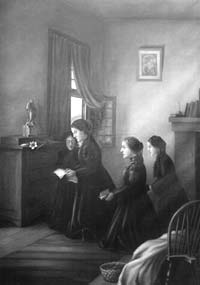 |
| |
Catherine Cusson,
Louise Thaumur la Source,
Catherine Demers and Marguerite, kneeling before the statue
of Our Lady of Providence |
Seeing
Marguerite selflessly caring for the poor, inspired three women to
join her. On December 31, 1737, Catherine Cusson, Louise Thaumur la
Source, and Catherine Demers joined Marguerite. They consecrated themselves
to God, promising secretly to serve Jesus in His poor. And so they
went to live with our friend. Completely dedicated to her mission
of charity, Madame d’Youville rented a larger house to receive the
poor. She and her three companions entered this house on October 30,
1738. As they stepped into their new place, their first act was to
kneel before the statue of Our Lady of Providence. They placed their
work of helping the poor under the protection of Our Lady, and consecrated
themselves to God, to serve the poor and most destitute members of
her Divine Son, till the end of their lives. Marguerite was 37 years
old… Like the saints, the members of the little society were persecuted
and contradicted. People were even more disturbed over the opening
of this house. Two days after its opening, on All Saints day, they
threw stones at Madame d’Youville and her companions on their way
to church! Their maliciousness went even further when they heard rumors
that Fr. Louis Normant, the Superior of the Sulpicians – and Marguerite’s
new spiritual director, wanted her and her companions to take over
Montreal’s General Hospital for the poor, established in 1693 by the
Charon Brothers! The people had other plans for the dilapidated hospital.
Even Marguerite’s own relatives and friends were shocked by what she
was doing and questioned her motives – her two brothers-in-law even
signed a petition addressed to the Secretary of State, opposing such
a move. Class-consciousness was strong in culture, in those days,
and Marguerite had started something that was just not done by persons
of her standing. Even the local parish priest believed in the calumnies
made against the little community, and refused to give its members
Holy Communion! But despite these persecutions, Mother d’Youville
and her companions remained peaceful, and continued working devotedly
and courageously, finding their best support through prayer. It was
when things looked the most desperate that Marguerite was most trusting
in God’s help, and felt most His closeness to her.
| |
 |
| |
The
Eternal Father
painted by Challe in 1741 |
On
February 20, 1741, Sr. Catherine Cusson died of tuberculosis at the
age of 32. During the three short years of her religious life, she
was distinguished by her charity to the poor and by her exact observance
of the rule. To Marguerite, the loss of this spiritual daughter was
as painful as that of her natural children had been. And even while
the weight of Sr. Catherine’s death weighed in the hearts of the nuns,
another threatened loss of far greater weight sent the Sisters to
their knees in urgent prayer. Fr. Normant, their Superior, had become
so dangerously ill that any hope of his recovery was almost abandoned.
Pounding on the doors of Heaven, Marguerite solemnly promised that
if Fr. Normant were restored to health, she would have a votive light
burned before the Blessed Sacrament every year on the Feast of the
of the Presentation of the Blessed Virgin Mary – a feast of deep significance
to the Sulpicians. Moreover she promised to have a special painting
made of the Eternal Father by an artist in France. This was a promise
that would be quite costly for the struggling community, but no sacrifice
was too great for the life of their beloved director. Fr. Normant
recovered his health – and since then, a beautiful painting of the
Eternal Father, painted by Challe in 1741, hangs in the vast community
room in the Motherhouse in Montreal. For some time our friend was
also praying for the healing of her knees, not because of the suffering,
but rather of the impossibility she had to continue to work. Here
again, she was miraculously healed one day.
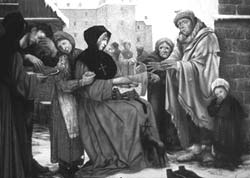 |
|
Marguerite helping the poor |
|
Marguerite
and her companions were now sharing their home with three boarders
and ten destitute persons. All were living happily in their cramped
quarters but suddenly their joy turned to sorrow when during the night
of January 31, 1745, a fire completely destroyed their home. It was
devastating to the residents, but Marguerite promised them that she
would not abandon them. With unwavering trust in Divine Providence,
she resolved to start over. While the fire was raging, a group of
bystanders were heard to shout: “Look at those purple flames! …
Those women are drunk!” (N.B. In French the word “grey” is translated
“gris”, and it not only means the color, but also the fact of being
drunk. So from the day of the fire, people started calling the sisters
“Grey Nuns”, meaning “Drunken Nuns”. By humility, and to show her
nuns should be inebriated by the love of God and neighbor, Marguerite
kept that nickname for her community). After all was Marguerite not
the widow of François d’Youville, who had dealt in illegal liquor
trading with the Indians? Marguerite knew that the people suspected
her and her companions of manufacturing alcohol in their home, but
she held no grudges – God was watching over all! After the fire, Marguerite
asked herself, “What can we learn from this? … Perhaps we have
been too well off. Now we will have to live more poorly!” This
resolve was carried out two days later on February 2, 1745, when Marguerite,
then aged 44, and the other Sisters, signed the “Original Commitment”.
Part of this founding document reads: … “for the greater glory
of God … for the relief of the poor … we are united in pure charity
to live and die together … to consecrate without reserve our time,
our days, indeed our entire life, to labor … to receive, feed and
support as many poor as we can take care of …” And since that
day, every Grey Nun has signed her name to this commitment!
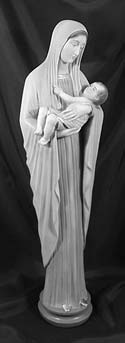 |
|
Our Lady of Providence |
|
On
October 7, 1747, a small procession made its way toward the General
Hospital of Montreal. Marguerite had been appointed temporary director
of the General Hospital, which was falling into ruins. It was a last
resort; as nobody could be found to administer this neglected institution.
The founder, who was too weak to walk, was seated on an old mattress
in a cart. She had to travel this way as she was exhausted after the
stress of the recent fire and the frequent moves that followed. Her
companions, some aged people and an orphan followed her on foot. And
at the same time poor Marguerite had to endure the laughing of the
people they passed by. Arriving at the hospital, Marguerite found
that four elderly men and two aged Brothers were living there under
deplorable conditions. After attending to their urgent needs, Marguerite’s
creative ingenuity and the energetic activity of her sisters made
the hospital livable. After only three years as Director of the General
Hospital, Marguerite had completely renovated it.
She
was therefore sadly surprised when she was in the market place one
day, and heard by a public announcement that the General Hospital
was to be merged with the one in Quebec, where its poor people was
to be transferred! The authorities had decided that there was need
for only one hospital of this kind. But Marguerite is convinced: The
General Hospital belongs to those who need it badly: the poor! She
therefore tries all she humanly can to have the decision changed.
But the opposition of Intendant François Bigot, representative of
the King of France, and the disapproval of Bishop de Pontbriand of
Quebec, was a heavy blow to Marguerite. She tried to soften its impact
on her sisters and their charges: “If God calls us to govern this
house, His plan will succeed; the impediments and opposition of men
should not trouble us.” She will also write: “Divine Providence
is truly admirable. God has a way of comforting those who depend on
Him, no matter what happens. I place all my trust in Him!” And
Marguerite’s hope was not in vain… prominent citizens joined her in
filing objections to the Ordinance. Among them were many who had put
their names to the earlier document repudiating “Les Soeurs Grises.”
The Sulpicians who had always supported Marguerite’s work, asked their
members in France to appeal to the Royal Court and on May 12, 1752,
the Ordinance of October 1750 was retracted. And in 1753, King Louis
XV of France, signed the “Letters Patent” which sanctioned the appointment
of Marguerite d’Youville as Directress of the General Hospital of
Montreal. More importantly, the document also established, for the
civil part, the new institute of the Sisters of Charity, known as
the Grey Nuns. Another great joy was soon to follow these…
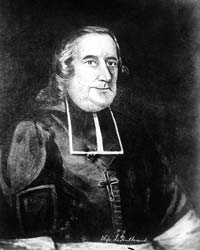 |
|
|
Bishop Henri de Pontbriand
(1708-1760) |
|
Indeed,
Bishop de Pontbriand, although for some time an admirer of the nuns,
hesitated to approve officially their Constitutions and costume: he
thought the sisters were so fervent they would never need such rigid
rules. But two years later, in 1755, he went along with their wishes
and gave his canonical approval. That same year on August 25th,
Fr. Louis Normant, co-founder of the Institute, bestowed on Mother
d’Youville, who was now 54, and her companions, the religious habit
– a simple grey dress and black head covering, similar to a widow’s
bonnet. They also wore a silver cross with a heart in relief, at the
centre. A fleur-de-lis at each corner of the cross commemorated their
French origin. Because of their grey habit, the Sisters were now affectionately
called: the Grey Nuns. They were now respected by the people and were
regarded as Mothers and Sisters to the poor, the elderly, orphans,
and prostitutes, the mentally ill, physically handicapped, chronically
ill and abandoned infants. Their work was now recognized for what
it was: a mission of charity and love. In this same year, Mother
d’Youville and her companions began their work as nurses during an
epidemic of chicken pox. The disease also spread to the Indian missions
around Montreal. Since they were not cloistered nuns, Marguerite and
her companions would go into homes and take care of the sick that
could not be hospitalized.
In
1756, war was officially declared between France and England. It was
the famous “Seven Years War”, and it extended to the colonies in Asia,
Africa, and the Americas. The Canadians, under the leadership of the
great General Montcalm were at first victorious and seized many English
forts. But after a while, lacking support from the central government
in France, they lost them, and even some of their own forts. Inexorably
the war was transporting itself to the core of Canada: the St. Lawrence
River Valley. The young but able English General Wolfe came in June
1759 with a fleet transporting several thousand men, and anchored
in front of Quebec City. He soon took the town of Lévis and Orleans
Island. He besieged Quebec City and took her in September. Then it
was Montreal’s turn. From the beginning, the Grey Nuns had extra work,
taking care of the wounded from both sides, and of the widows and
orphans. Marguerite will even help some wounded English prisoners
to escape the wrath of the Indians allied to the French! The situation
in the Canadian colony was very difficult. All able-bodied men were
in the army; consequently the fields were not cultivated and food
was in short supply. Sounds of rifle fire mingled with cries of anger,
frustration and sorrow were heard day and night.
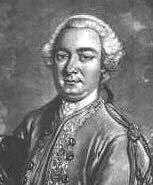 |
|
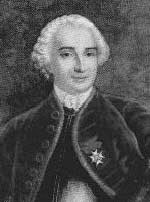 |
General
Louis Joseph de Montcalm (1712-1759)
|
|
General
James Wolfe
(1727-59)
|
One
of the greatest consolations Mother d’Youville had during her life
was her two sons becoming priests. But during the siege of Quebec,
Father Charles, the younger of Mother d’Youville’s sons, was imprisoned
aboard an English frigate along with his parishioners. Marguerite
feared for his safety. Four months later at the surrender of Quebec,
the prisoners were released, unharmed. When Montreal surrenders,
in 1760, the end of a world is happening: that of a Catholic Canada.
In 1763 the Catholic King of France will officially give away his
colony of Canada to the Protestant King of England. Mother d’Youville
shares her suffering with us: “To lose our King, our country, our
possessions, and worse still: to fear to see our Holy Religion vanish,
it is all very difficult to bear!”Indeed the British Military
Regime starts then, and soon harasses and persecutes the Catholic
Religion and its clergy. It will take many years of struggle, diplomacy,
and persevering prayer to obtain freedom of Religion from the new
masters. But this is another story… Many French and Canadian citizens
returned to France rather than live under English rule. The small
people, attached to a land they had worked for generations remained,
together with a few members of the nobility. Mother d’Youville found
it hard to say goodbye to those close to her, but for Marguerite there
was no question of leaving. Those in need of the Grey Nuns had never
been so numerous.
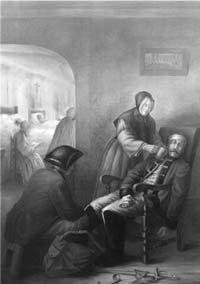 |
|
|
Caring for Injured Soldiers
during War of 1758-1760 |
|
On
May 18, 1765, a fire started which threatened to destroy the entire
city of Montreal! Marguerite sent all those she could, to help control
the blaze. But tragically, the wind turned direction and the General
Hospital was completely destroyed! Several hours later, Marguerite
stood before the smoking ruins; she gathered everyone around her and
said, “We are going to recite the ‘Te Deum’ on our knees,
to thank God for the cross He has just sent us!” God will reward
her with the promise that never again will any fire touch the General
Hospital, and this came to be. The great stonewalls were still standing,
though, and Marguerite regarded it as a sign of God’s Providence
when she found the painting of the Eternal Father unharmed among the
ruins. The statue of Our Lady of Providence, before which she and
her early companions had made their consecration, had also been preserved.
Fortified by these signs of God’s love, Marguerite, now 64 will start
with great and communicative energy the rebuilding of the General
Hospital. In the meantime all the Grey Nuns, and those they had under
care, were lodged at the Hotel-Dieu, the hospital managed by the Sisters
of St. Joseph. Thanks to the numerous donations of the people - even
those of the Indians, who did not forget Marguerite’s generosity during
the 1755 smallpox epidemic - the General Hospital was soon back “on
its feet”.
Three
years later Marguerite will complain that she doesn’t have enough
resources to welcome all those who are in need. It was certainly not
for lack of keenness and industry, because she indeed was a remarkable
businesswoman! For instance, she acquired in 1768 the Seigniory of
Chateauguay and St. Bernard Island. She also supervised the construction
of a building at Pointe St. Charles. Nevertheless, the burden is terrible:
alone with 17 aging nuns, Marguerite had to shelter, feed, clean,
170 patients and poor! She writes, “There is so much good we could
do if only we had the means. Everyday the poor who are in need come
to us, and I cry bitterly that I have to send them away. If I knew
how to obtain funds without stealing, I would have a new building,
large enough to house 200 people, but I have nothing! Nevertheless,
I must believe that God is satisfied with our good intentions.”
Her trust in God’ Providence was rewarded one day, when there was
practically nothing left in the house: They found one morning several
barrels of fine wheat flour in their refectory.
No one ever discovered where they came from.
| |
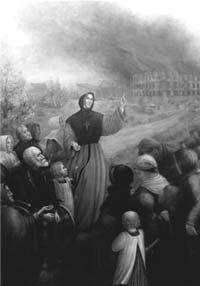 |
| |
Fire Destroys General Hospital
(1765) |
In
the last remaining years of her life, Mother d’Youville continued
correcting the sisters and teaching them the ways of God. She didn’t
let any occasion slip by; knowing how important it was to make sure
that the virtue of charity was running in their veins, charity between
themselves and also for the poor and destitute. But Marguerite could
not live forever in this world – working day and night to serve the
poor, and the sisters in her charge, her health could not hold out.
During the autumn of 1771, Marguerite’s health began to fail, and
in early December she suffered a stroke. When later she had another
stroke and became paralyzed, she knew that her service to the poor
would soon come to an end. She also knew that her last words would
make a permanent impression on those whose lives were intertwined
with her own. To her spiritual daughters, she bequeathed her great
spirit of charity, recommending that they should “remain faithful
to the duties of the life they have embraced… and always follow the
paths of regularity, obedience, mortification, but most of all, the
most perfect union should always reign among them.” On December
23rd, around 8:30 in the evening, Mother d’Youville passed
into the arms of God. She was 70 years old. At that very moment, a
luminous cross appeared in the sky above the hospital. With astonishment,
the passers-by noticed the strange sight and considered it miraculous.
One of them, named Jean Delisle, understood Marguerite had just left
this world and exclaimed: “Oh! What a cross for these poor Grey
Nuns!”
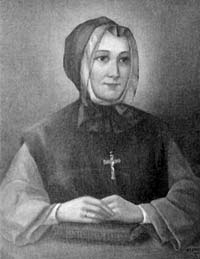 |
|
|
Saint
Marguerite d’Youville |
|
Indeed,
this was a great loss for the community, and for Canada. But joy replaced
sorrow in their hearts, because they were certain Marguerite was a
Saint. Had she not shown, during all of her life, the example of all
virtues? Yes. And what made Marguerite walk with unfaltering steps
in fulfillment of the mission God had given her? It was truly her
faith and trust in Divine Providence, her sincere love of the poor
and her communion with God in prayer. Each morning she offered herself
to God the Father, in union with Jesus, to spend the day in His love.
In simplicity of heart, she sought God in the poor. In the events
of daily life and in every opportunity to respond to unmet needs,
she saw God’s great plan of universal love. One of the greatest traits
of Marguerite d’Youville’s character was that she did not permit herself
to dwell inordinately on the misfortunes of her life. She kept sorrow
in its place, and never let it get the best of her. By doing this
Marguerite was able to keep abreast of all her troubles and woes,
and concentrate on doing good works and carrying her cross with joy.
Recognizing her heroic practice of virtue, Holy Mother Church decided
to place her on the altars. On May 3rd 1959, Pope John
XXIII beatified her, and gave her the title “Mother of the Universal
Charity”, and on December 9th 1990, Pope John Paul II canonized
her, proposing her to our veneration and imitation. Surely we can
all follow Marguerite’s excellent example of being submitted to God’s
Holy Will, or at least we can make greater efforts to do this – for
in doing so, we begin to have heaven on earth; and what’s more, peace
of soul goes with this. Let us pray then to good Mother d’Youville
to help us in our daily efforts to practice charity – she who knew
so well how to practice this beautiful virtue. ←
Saint
Marguerite d’Youville Pray for Us!